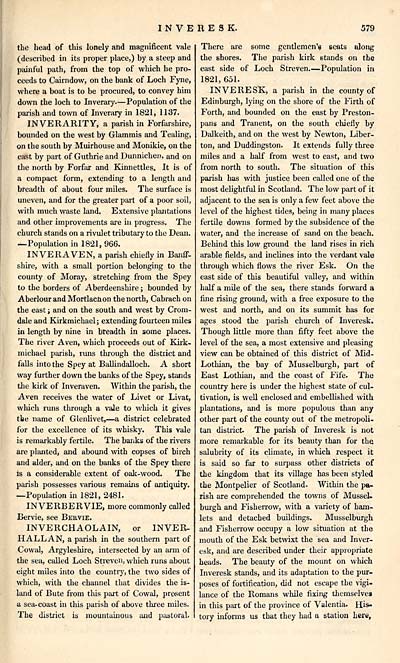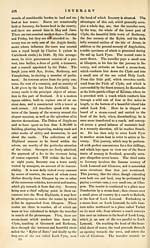Gazetteer of Scotland > Volume 2
(95) Page 579
Download files
Complete book:
Individual page:
Thumbnail gallery: Grid view | List view

INVERE9K.
579
the head of this lonely and magnificent vale
(described in its proper place,) by a steep and
painful path, from the top of which he pro-
ceeds to Cairndow, on the bank of Loch Fyne,
where a boat is to be procured, to convey him
down the loch to Inverary — Population of the
parish and town of Inverary in 1821, 1137.
IN VE RARITY, a parish in Forfarshire,
bounded on the west by Glammis and Tealing,
on the south by Muirhouse and Monikie, on the
east by part of Guthrie and Dunnichen, and on
the north by Forfar and Kinnettles. It is of
a compact form, extending to a length and
breadth of about four miles. The surface is
uneven, and for the greater part of a poor soil,
with much waste land. Extensive plantations
and other improvements are in progress. The
church stands on a rivulet tributary to the Dean.
— Population in 1821, 966.
IN VE RAVEN, a parish chiefly in Banff-
shire, with a small portion belonging to the
county of Moray, stretching from the Spey
to the borders of Aberdeenshire ; bounded by
AberlourandMortlacnon the north, Cabrach on
the east ; and on the south and west by Crom-
dale and Kirkmichael; extending fourteen miles
in length by nine in breadth in some places.
The river Aven, which proceeds out of Kirk-
michael parish, runs through the district and
falls into the Spey at Ballindalloch. A short
way further down the banks of the Spey, stands
the kirk of Inveraven. Within the parish, the
Aven receives the water of Livet or Livat,
which runs through a vale to which it gives
the name of Glenlivet, — a district celebrated
for the excellence of its whisky. This vale
is remarkably fertile. The banks of the rivers
are planted, and abound with copses of birch
and alder, and on the banks of the Spey there
is a considerable extent of oak-wood. The
parish possesses various remains of antiquity.
—Population in 1821, 2481.
INVERBERVIE, more commonly called
Bervie, see Bervie.
INVERCHAOLAIN, or INVER-
HALLAN, a parish in the southern part of
Cowal, Argyleshire, intersected by an arm of
the sea, called Loch Streven, which runs about
eight miles into the country, the two sides of
which, with the channel that divides the is-
land of Bute from this part of Cowal, present
a sea- coast in this parish of above three miles.
The district is mountainous and pastoral.
There are some gentlemen's seats along
the shores. The parish kirk 6tands on the
east side of Loch Streven. — Population in
1821, 651.
INVERESK, a parish in the county of
Edinburgh, lying on the shore of the Firth of
Forth, and bounded on the east by Preston-
pans and Tranent, on the south chiefly by
Dalkeith, and on the west by Newton, Liber-
ton, and Duddingston. It extends fully three
miles and a half from west to east, and two
from north to south. The situation of this
parish has with justice been called one of the
most delightful in Scotland. The low part of it
adjacent to the sea is only a few feet above the
level of the highest tides, being in many places
fertile downs formed by the subsidence of the
water, and the increase of sand on the beach.
Behind this low ground the land rises in rich
arable fields, and inclines into the verdant vale
through which flows the river Esk. On the
east side of this beautiful valley, and within
half a mile of the sea, there stands forward a
fine rising ground, with a free exposure to the
west and north, and on its summit has for
ages stood the parish church of Inveresk.
Though little more than fifty feet above the
level of the sea, a most extensive and pleasing
view can be obtained of this district of Mid-
Lothian, the bay of Musselburgh, part of
East Lothian, and the coast of Fife. The
country here is under the highest state of cul-
tivation, is well enclosed and embellished with
plantations, and is more populous than any
other part of the county out of the metropoli-
tan district. The parish of Inveresk is not
more remarkable for its beauty than for the
salubrity of its climate, in which respect it
is said so far to surpass other districts of
the kingdom that its village has been styled
the Montpelier of Scotland. Within the pa-
rish are comprehended the towns of Mussel,
burgh and Fisherrow, with a variety of ham-
lets and detached buildings. Musselburgh
and Fisherrow occupy a low situation at the
mouth of the Esk betwixt the sea and Inver-
esk, and are described under their appropriate
heads. The beauty of the mount on which
Inveresk stands, and its adaptation to the pur-
poses of fortification, did not escape the vigi-
lance of the Romans while fixing themselves
in this part of the province of Valentia. His-
tory informs us that they had a station here,
579
the head of this lonely and magnificent vale
(described in its proper place,) by a steep and
painful path, from the top of which he pro-
ceeds to Cairndow, on the bank of Loch Fyne,
where a boat is to be procured, to convey him
down the loch to Inverary — Population of the
parish and town of Inverary in 1821, 1137.
IN VE RARITY, a parish in Forfarshire,
bounded on the west by Glammis and Tealing,
on the south by Muirhouse and Monikie, on the
east by part of Guthrie and Dunnichen, and on
the north by Forfar and Kinnettles. It is of
a compact form, extending to a length and
breadth of about four miles. The surface is
uneven, and for the greater part of a poor soil,
with much waste land. Extensive plantations
and other improvements are in progress. The
church stands on a rivulet tributary to the Dean.
— Population in 1821, 966.
IN VE RAVEN, a parish chiefly in Banff-
shire, with a small portion belonging to the
county of Moray, stretching from the Spey
to the borders of Aberdeenshire ; bounded by
AberlourandMortlacnon the north, Cabrach on
the east ; and on the south and west by Crom-
dale and Kirkmichael; extending fourteen miles
in length by nine in breadth in some places.
The river Aven, which proceeds out of Kirk-
michael parish, runs through the district and
falls into the Spey at Ballindalloch. A short
way further down the banks of the Spey, stands
the kirk of Inveraven. Within the parish, the
Aven receives the water of Livet or Livat,
which runs through a vale to which it gives
the name of Glenlivet, — a district celebrated
for the excellence of its whisky. This vale
is remarkably fertile. The banks of the rivers
are planted, and abound with copses of birch
and alder, and on the banks of the Spey there
is a considerable extent of oak-wood. The
parish possesses various remains of antiquity.
—Population in 1821, 2481.
INVERBERVIE, more commonly called
Bervie, see Bervie.
INVERCHAOLAIN, or INVER-
HALLAN, a parish in the southern part of
Cowal, Argyleshire, intersected by an arm of
the sea, called Loch Streven, which runs about
eight miles into the country, the two sides of
which, with the channel that divides the is-
land of Bute from this part of Cowal, present
a sea- coast in this parish of above three miles.
The district is mountainous and pastoral.
There are some gentlemen's seats along
the shores. The parish kirk 6tands on the
east side of Loch Streven. — Population in
1821, 651.
INVERESK, a parish in the county of
Edinburgh, lying on the shore of the Firth of
Forth, and bounded on the east by Preston-
pans and Tranent, on the south chiefly by
Dalkeith, and on the west by Newton, Liber-
ton, and Duddingston. It extends fully three
miles and a half from west to east, and two
from north to south. The situation of this
parish has with justice been called one of the
most delightful in Scotland. The low part of it
adjacent to the sea is only a few feet above the
level of the highest tides, being in many places
fertile downs formed by the subsidence of the
water, and the increase of sand on the beach.
Behind this low ground the land rises in rich
arable fields, and inclines into the verdant vale
through which flows the river Esk. On the
east side of this beautiful valley, and within
half a mile of the sea, there stands forward a
fine rising ground, with a free exposure to the
west and north, and on its summit has for
ages stood the parish church of Inveresk.
Though little more than fifty feet above the
level of the sea, a most extensive and pleasing
view can be obtained of this district of Mid-
Lothian, the bay of Musselburgh, part of
East Lothian, and the coast of Fife. The
country here is under the highest state of cul-
tivation, is well enclosed and embellished with
plantations, and is more populous than any
other part of the county out of the metropoli-
tan district. The parish of Inveresk is not
more remarkable for its beauty than for the
salubrity of its climate, in which respect it
is said so far to surpass other districts of
the kingdom that its village has been styled
the Montpelier of Scotland. Within the pa-
rish are comprehended the towns of Mussel,
burgh and Fisherrow, with a variety of ham-
lets and detached buildings. Musselburgh
and Fisherrow occupy a low situation at the
mouth of the Esk betwixt the sea and Inver-
esk, and are described under their appropriate
heads. The beauty of the mount on which
Inveresk stands, and its adaptation to the pur-
poses of fortification, did not escape the vigi-
lance of the Romans while fixing themselves
in this part of the province of Valentia. His-
tory informs us that they had a station here,
Set display mode to: Large image | Transcription
Images and transcriptions on this page, including medium image downloads, may be used under the Creative Commons Attribution 4.0 International Licence unless otherwise stated. ![]()
| Gazetteers of Scotland, 1803-1901 > Gazetteer of Scotland > Volume 2 > (95) Page 579 |
|---|
| Permanent URL | https://digital.nls.uk/97431962 |
|---|
| Description | Volume II: Glenbanchor to Zetland. |
|---|---|
| Attribution and copyright: |
|
| Description | By Robert Chambers and William Chambers. Glasgow: Blackie & Son, 1838. 2 volumes. |
|---|---|
| Shelfmark | NF.1461.g.7 |
| Additional NLS resources: | |

